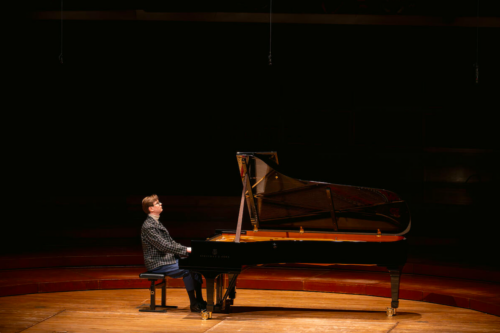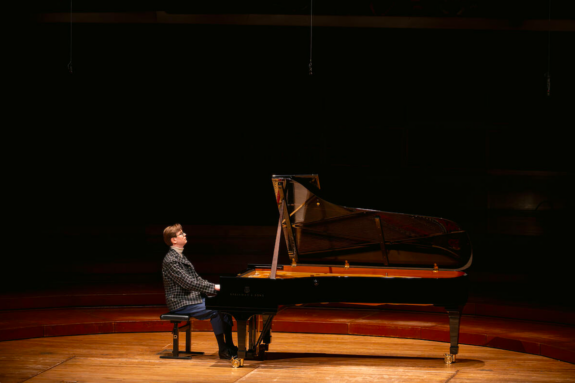 United States Bach: Vikingur Ólafsson (piano). San Francisco Symphony Great Performers Series, Davies Symphony Hall, San Francisco, 2.3.2025. (HS)
United States Bach: Vikingur Ólafsson (piano). San Francisco Symphony Great Performers Series, Davies Symphony Hall, San Francisco, 2.3.2025. (HS)

J. S. Bach – Goldberg Variations
The nearly-full audience settled in Davies Hall to hear two of today’s piano giants in a duo recital. Yuja Wang and Vikingur Ólafsson had wowed audiences and critics alike with performances in New York and Cleveland earlier last week, and both had played concertos in recent weeks with the San Francisco Symphony. Anticipation was high.
But something was amiss. Only one piano greeted us on the stage for a program centered on two-piano works by Schubert, Adams and Rachmaninoff. The starting time came and went, and ten minutes later it was announced that Wang had decided just two hours before that she could not play. Ólafsson later told the audience that she had an infected finger.
The remedy was for Ólafsson to deliver a scintillating Goldberg Variations. It is a piece he had performed more than ninety times in the past year, and he had earned a Grammy for his distinctive interpretation on a recording. Not only was it lauded for its freshness and insight, but also for his formidable technique. He can blaze through the complex fast counterpoint with ease, and his sensitive approach to slow, quiet music can make the piano sing.
Appropriately for that, Bach used Aria as the title of the theme. Ólafsson delivered it with a minimum of ornamentation, and its simplicity set up the first of many contrasts that characterized this performance of the thirty variations.
After the stately pace and naturalness of the Aria, the first handful of variations burst forth at a more rapid clip than we usually hear in other performances. That fit with an interpretation he described in the program note to his recording, which outlined a sense that Bach’s first fifteen variations represent the enthusiasm and recklessness of youth. The second half, he wrote, is more layered, more complex, more worldly, and when the opening Aria comes back at the end we hear it in a very different, more personal context.
If those first variations sped by so breathlessly that some details did not quite emerge, the feistiness and rhythmic vitality and immediacy was captivating. Just watching Ólafsson’s hands sailing around and crossing over the keyboard was mesmerizing, and there was distinctiveness despite the overall sense of rapidity. The lilting ‘Gigue’ (No.7) practically lifted into the air. The heavily decorated (by Bach) but slow and gentle No.13 seemed to float in contrast to the fast ones around it. In the intensely reverent No.15, subtle suspensions in the spaces between iterations of the melodies encouraged us to breathe, all the while yearning for the next phrase.
The ‘French Overture’ (No.16), which heralds the second half, started less emphatically than most performances do, but quickly picked up steam once the quicker rhythm kicked in. The short variations that followed were notable for their clarity, but what really stopped the show – in two senses of the phrase – was the famous ‘Black Pearl’ (No.25). Marked Adagio, it is harmonically rich and the longest of all. Ólafsson seemed intent on drawing out the pace to its max. It was so profound that I expect many in the audience, like the pianist, were unwilling for it to end.
For me, the last five variations often deliver the biggest rewards of all. In Ólafsson’s hands, this sequence of fast-moving toccatas and canons, arpeggios spraying around and intensely rigorous rhythms, came at us, each at what felt like the exact same tempo. It was as if the pianist wanted to build a composite single movement to outdo the lengthy ‘Black Pearl’.
Was it thrilling? Absolutely, even if the insistent pace blurred distinctions between the variations. It wasn’t until the majestic No.30, ‘Quodlibet’, and its introduction of folk tunes that something clearly distinctive emerged. And what an impact this movement had! – a contrast (there is that word again) to the four that preceded it.
After that, the return to the Aria felt even more tender. The pauses took longer breaths between phrases. Only when the final notes slowed to a finish, Ólafsson’s hands held over the keyboard to create a long silence, did the enchantment dispel.
Taking bows, he even held up both hands to interrupt a standing ovation to apologize for not offering encores. ‘Bach wrote his own encore, and there’s no place to go from there’, he shrugged. The ovation continued.
Harvey Steiman
